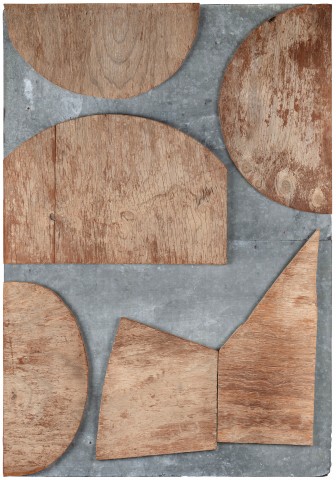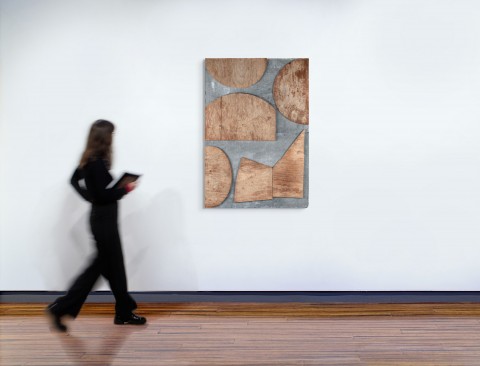ON A CLEAR DAY, 1988
ROSALIE GASCOIGNE
weathered, sawn plywood on weathered galvanized iron on plywood
132.0 x 91.0 cm
signed, dated and inscribed with title verso: “ON A CLEAR DAY” / 1988 / Rosalie Gascoigne
Pinacotheca, Melbourne
Private collection, Queensland, acquired from the above in 1988
Rosalie Gascoigne, Pinacotheca, Melbourne, 28 September – 15 October 1988, cat. 19
MacDonald, V., Rosalie Gascoigne, Regaro, Sydney, 1998, p. 106
Gascoigne, M., Rosalie Gascoigne: A Catalogue Raisonné, Australian National University Press, Canberra, 2019, cat. 329, pp. 233 (illus.), 331
When Rosalie Gascoigne made On a Clear Day in 1988, she had been exhibiting for just 14 years, not yet quite classifiable, at the age of 71, as a mid-career artist. However, in this relatively short space of time, her work had already been included in a raft of significant exhibitions, including two Sydney Biennales (1979 and 1988), and she had been honoured, in 1982, as the first woman to represent Australia at the Venice Biennale.1 She was at the height of her powers.
As an artist, Gascoigne seemed to emerge fully formed, capturing the art world’s imagination as a result. But she had, as curator and art historian Deborah Clark has acknowledged, ‘been rehearsing for it all her life.’2 With a background in Sogetsu Ikebana, a sharp and inquisitive intellect, and a keen eye, Gascoigne had been making ‘arrangements’ with things selected from the natural world for most of her life, and it is from this experience that she developed the unique visual language that was to catapult her to international success. While Gascoigne proposed that the seemingly singular nature of her practice stemmed from the fact that her vision was neither tainted nor influenced by her being taught the ‘rules’, the necessity and power of her art nevertheless remained for her an essential truth. As she stated:
‘For me, the bottom line in art is honesty. It depends on how much you have inside yourself, as to how much you can put into a work of art. I look for the eternal truths in nature, the rhythms, cycles, seasons, shapes, regeneration, restorative powers, spirit. I’m showing what I believe to be interesting and beautiful.’3
Gascoigne loved weathered wood, which she collected from dumps, building sites and recycling centres, and the composition of On a Clear Day would have resulted from her moving the different pieces of found plywood around until they ‘fell into place’. The influence of ikebana is clearly embodied in the work’s restrained and elegant aesthetic; its quiet solemnity derived as much from the marriage of simple shapes and restricted palette as from what is left out. Indeed, its success comes from a knowing combination of intuition and discipline and the artist’s concentrated search for an essential form that is equally based upon a ruthless sense of acceptance or rejection. The work’s title, which would have been given to the piece after its completion, adds the final touch – evoking both the way in which forms in the natural world are crisply delineated on a clear day, and the lyrics of the song from the 1965 Broadway musical On a Clear Day You Can See Forever, made famous by Barbara Streisand in the 1970 film adaptation: ‘On a clear day / Rise and look around you / And you'll see who / You are … And on a clear day / On that clear day / You can see forever and ever / And ever / And evermore’.
1. Technically, Thea Proctor (1879 – 1966) was the first Australian woman to have her work exhibited at the Venice Biennale (in 1912), but her work was shown as part of the British representation.
2. Clark, D., ‘Rosalie Gascoigne 1917 – 1999’, Art Monthly Australia, no. 127, December 1999, p. 38
3. Hawley, J. ‘A Late Developer’, Good Weekend, Sydney Morning Herald, Sydney, 15 November 1997, p. 44
KELLY GELLATLY

